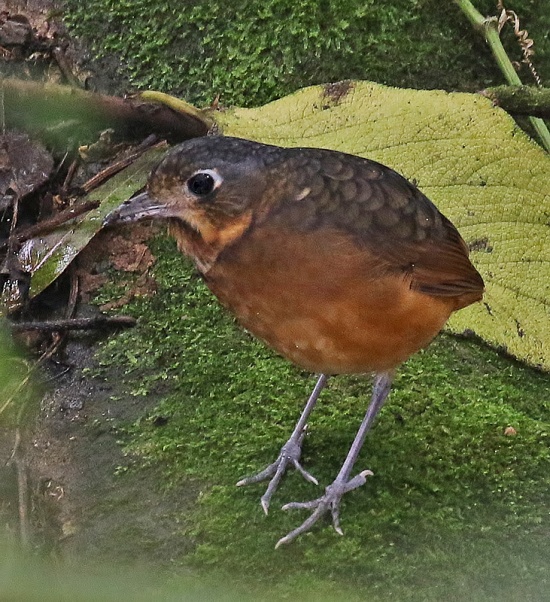
(Grallaria guatimalensis princeps)
Photo by Tepke Glen Tepke
San Gerardo de Dota, Costa Rica, August 2015
Photo by Tepke Glen Tepke
San Gerardo de Dota, Costa Rica, August 2015
| This article is incomplete. This article is missing one or more sections. You can help the BirdForum Opus by expanding it. |
- Grallaria guatimalensis
Identification
18cm
- Grey nape
- Olive brown crown and upperparts, feathers scaled black
- Brown throat
- Cinnamon underparts
Distribution
Central and South America
Central America: Mexico, Guatemala, Belize, El Salvador, Honduras, Nicaragua, Costa Rica and Panama
South America: Colombia, Venezuela, Guyana, Ecuador, Peru and Bolivia.
Taxonomy
Subspecies
There are 9 subspecies[1]:
- G. g. ochraceiventris: Mountains of south-western Mexico (Jalisco to Hidalgo, Guerrero and Morelos)
- G. g. guatimalensis: Southern Mexico (north-western Veracruz and Oaxaca) to northern Nicaragua
- G. g. princeps: Subtropical Costa Rica to western Panama (Veraguas)
- G. g. chocoensis: Mountains of eastern Panama (Darién) and north-western Colombia (Chocó)
- G. g. carmelitae: Santa Marta Mountains (north-eastern Colombia) and Sierra de Perijá
- G. g. aripoensis: Trinidad
- G. g. regulus: Andes of Colombia, eastern Ecuador and Peru (south to Cusco)
- G. g. sororia: Southern Peru (Cusco) to central Bolivia (Santa Cruz)
- G. g. roraimae: Tepuis of southern Venezuela, adjacent northern Brazil and western Guyana
An additional subspecies binfordi is not recognised by most authorities[2].
Habitat
Moist lowland forests and montanes.
Behaviour
Terrestrial.
Breeding
It builds a cup nest of sticks and leaves low in a shrub, into which 2 eggs are laid.
References
- Clements, JF. 2010. The Clements Checklist of Birds of the World. 6th ed., with updates to December 2010. Ithaca: Cornell Univ. Press. ISBN 978-0801445019. Spreadsheet available at http://www.birds.cornell.edu/clementschecklist/Clements%206.5.xls/view
- Avibase
Recommended Citation
- BirdForum Opus contributors. (2024) Scaled Antpitta. In: BirdForum, the forum for wild birds and birding. Retrieved 11 May 2024 from https://www.birdforum.net/opus/Scaled_Antpitta



